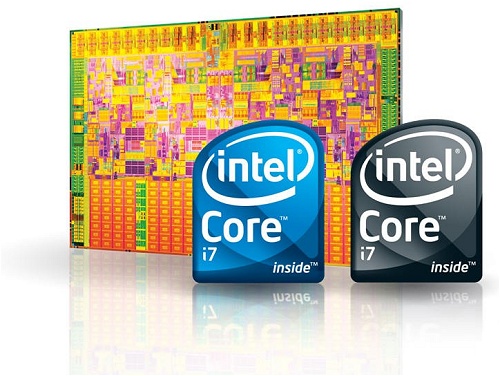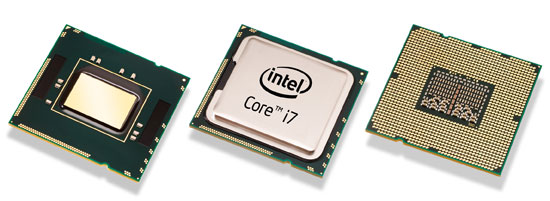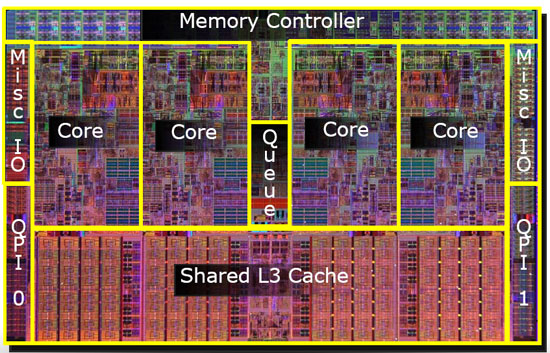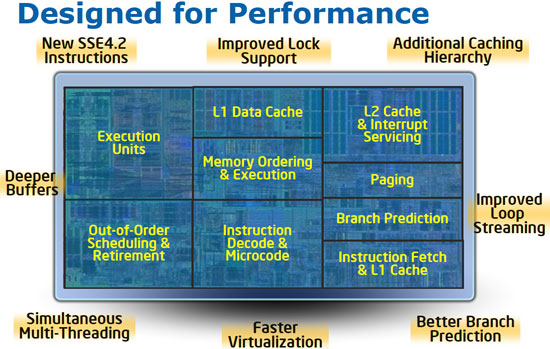We publish our first test results of the new Intel Core i7 processor -- the cheapest Core i7 920 model. This processor differs from the top Core i7 Extreme Edition 965 by a lower clock rate (2.66 GHz versus 3.20 GHz) and lower QPI bus bandwidth (4.8 GT/s versus 6.4 GT/s). As we already wrote, the latter fact theoretically shouldn't affect execution speed of most tasks (and almost certainly those tasks that we use in our tests). Thus, we were not too upset, when we failed to get the top processor from this series, as it's not very difficult to estimate performance of a processor, which differs from the tested sample in frequency only (accuracy of such estimation is usually very high). If you want to do it on your own, just multiply the result of Core i7 920 by 1.2, and you'll get an approximate performance level of Core i7 EE 965 even before a chance to test it.
We'd like to draw your attention to the testbed with Core i7 920, which was equipped with three DDR3-1333 Kingston KHX11000D3LLK3/3GX modules (operating in DDR3-1066 mode, as it's the maximum nominal frequency for Core i7) with the total volume of 3 GB instead of 4 GB in our standard testbed. We are going to expand this volume in the Core i7 testbed to 6 GB (3 x 2 GB Corsair TR3X6G1600C8D). But such modules were not available at the time of these tests yet. However, results we obtained suggest that the RAM volume reduced by 1 GB had little effect on the overall system performance.
What concerns the choice of competing products, for our first series of Core i7 tests we decided to pick them up by speed: five processors to accompany Core i7 920 in the following charts share one common property: their total performance score exceeds 100. The same concerns Core i7 920.
Now what concerns conditions of our Core i7 tests: as it's our first series of tests, we decided against experiments again (they will be included into another detailed review). So we tested our Core i7 920 in the purely nominal mode: Hyper-Threading and Turbo Boost enabled. That's how they will work in most computers after all.

Hardware and software
LGA775-based testbed
- Motherboard: ASUS Maximus Extreme
- Graphics card: GeForce 8800 GTX
- Memory: 4 GB (4 x Corsair CM3X1024-1800C7DIN)
- HDD: Samsung HD401LJ (SATA-2)
- Cooler: Thermaltake TMG i1
- PSU: Cooler Master RS-A00-EMBA
LGA1366-based testbed
- Motherboard: ASUS P6T Deluxe
- Graphics card: GeForce 8800 GTX
- Memory: 3 GB (3 x Kingston KHX11000D3LLK3/3GX)
- HDD: Samsung HD401LJ (SATA-2)
- Cooler: ASUS Triton 81
- PSU: Cooler Master RS-A00-EMBA
| Processor | Core 2 Duo E6850 | Core 2 Duo E8200 | Core 2 Duo E8500 | Core 2 Quad Q9300 | Core 2 Extreme QX9770 | Core i7 920 |
| Core | Conroe | Wolfdale | Wolfdale | Yorkfield | Yorkfield | Bloomfield |
| Process technology, nm | 65 | 45 | 45 | 45 | 45 | 45 |
| Core clock, GHz | 3.0 | 2.66 | 3.16 | 2.5 | 3.2 | 2.66 |
| Number of cores | 2 | 2 | 2 | 4 | 4 | 4 |
| Hyper-Threading | - | - | - | - | - | + |
| L1 cache, I/D, KB | 32/32 | 32/32 | 32/32 | 32/32 | 32/32 | 32/32 |
| L2 cache, KB | 4096 | 6144 | 6144 | 6144 | 12288 | 4 x 256 |
| L3 cache, KB | - | - | - | - | - | 8192 |
| FSB clock, MHz | 333 (1333) | 333 (1333) | 333 (1333) | 333 (1333) | 400 (1600) | 133* |
| Multiplier | 9 | 8 | 9.5 | 7.5 | 8 | 20 |
| Socket | LGA775 | LGA775 | LGA775 | LGA775 | LGA775 | LGA1366 |
| TDP, W | 65 | 65 | 65 | 95 | 136 | 130 |
* - In case of Core i7 we specify the so-called "reference frequency". CPU/memory/QPI frequencies are obtained by applying various multipliers to this frequency.
Software
| Benchmark | 64-bit application | Multi-threaded* |
| Microsoft Windows XP Professional SP2 | + | + |
| Microsoft Windows Vista Ultimate SP1 | + | + |
| Autodesk 3ds max 9 SP2 | + | + |
| V-Ray 1.5 SP1 | + | + |
| Autodesk Maya 2008 Ultimate | + | + |
| NewTek Lightwave 3D 9.2 | + | + |
| SolidWorks 2007SP0.0 | + | + |
| PTC Pro/ENGINEER Wildfire 3.0M120 | + | - |
| UGS NX55.0.0.25 | + | + |
| Wolfram Research Mathematica 6 | + | + |
| MapleSoft Maple 11 | - | + |
| MathWorks MATLAB 2007 | + | + |
| Adobe Photoshop CS3 10.0 | - | + |
| Microsoft Visual Studio 2008 | + | + |
| Apache HTTP Server 2.2.8 | - | + |
| PHP 5.2.5 | - | + |
| MySQL Community Server 5.0.51a | - | + |
| ACDSee 10 Photo Manager | - | + |
| xat.com Image Optimizer 5.10 | - | - |
| IrfanView 4.10 | - | - |
| XnView 1.93.4 | - | - |
| Paint.NET 3.30 | + | + |
| 7-Zip4.57 | + | + |
| WinRAR 3.71 | - | + |
| UltimateZip 3.2 | - | - |
| FLAC 1.2.1 | - | - |
| LAME-MT3.97 | + | + |
| Musepack MPC Encoder 1.16 | - | - |
| Nero Digital Audio Encoder 1.1.34.2 | - | + |
| Ogg Encoder 2.83 (Lancer) | - | + |
| Canopus ProCoder 3.0 | - | + |
| DivX Codec 6.8.2 | - | + |
| XviD Codec 1.1.3 Final | - | - |
| x264 Codec rev 807 | - | + |
| VirtualDub 1.8.0 | - | + |
| Call of Duty 4: Modern Warfare (Patch 1.5) | - | + |
| Call of Juarez (Patch 1.1.0.0) + DX10 Enhancements Pack | - | - |
| Crysis (Patch 1.2) | + | + |
| S.T.A.L.K.E.R. (Patch 1.006) | - | + |
| Unreal Tournament 3 (Patch 1.2) | - | + |
| Company of Heroes (Patch 1.71) | - | + |
| World in Conflict (Patch 1.007) | - | + |
* Means that two or more simultaneously active threads are actually present during tests; not just the fact that a process generates several threads.









